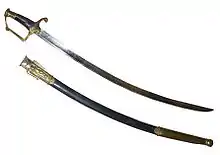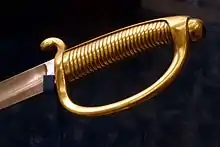佩劍 (西方)
佩劍 (西方),大部分有著彎曲的刀身與單面刀鋒(因真實軍隊使用的軍刀未必都是單刃的刀,所以後來也譯佩劍)。原是匈牙利人所使用的武器,使用的歷史最早可追溯到西元九世紀前後。多為騎兵所使用,為了方便在馬上單手使用,造得輕巧,刀身也盡量造得較長。刀身共有直刀身、微彎刀身、大彎刀身三種。根據FIE劍種說明,現代的運動項目用的佩劍是由十九世紀末海軍用劍發展而成的。
.jpg.webp)
現代美軍儀隊軍刀
来源
17世纪,被称为Sabre的佩剑传入西欧。它们来源于东欧Szabla型佩剑,最早是中世纪时的单刃刀。西欧开始配备这种刀始于匈牙利骠骑兵。[1]这些骑兵主要作为轻骑兵起到骚扰敌方散兵、蹂躏炮兵阵地和追逐逃兵的作用。17世纪末和18世纪,许多匈牙利骠骑兵逃亡到中、西欧国家并成为当地骠骑兵的中坚。[2]匈牙利语的“佩剑”----“Szablya”可以追溯至钦察突厥语的Selebe以及匈牙利语的Szab,意为“切”。
運動項目
參見
参考来源
- Encyclopedia, Online. . encyclopedia jrank. Encyclopædia Britannica. [01-08-2015]. (原始内容存档于2006-06-14).
- Bavaria raised its first hussar regiment in 1688 and a second one in about 1700. Prussia followed suit in 1721 when Frederick the Great used hussar units extensively during the War of the Austrian Succession. France established a number of hussar regiments from 1692 onward, recruiting originally from Hungary and Germany, then subsequently from German-speaking frontier regions within France itself. The first hussar regiment in France was founded by a Hungarian lieutenant named Ladislas Ignace de Bercheny. Hungarian-history.hu 页面存档备份,存于
This article is issued from Wikipedia. The text is licensed under Creative Commons - Attribution - Sharealike. Additional terms may apply for the media files.

